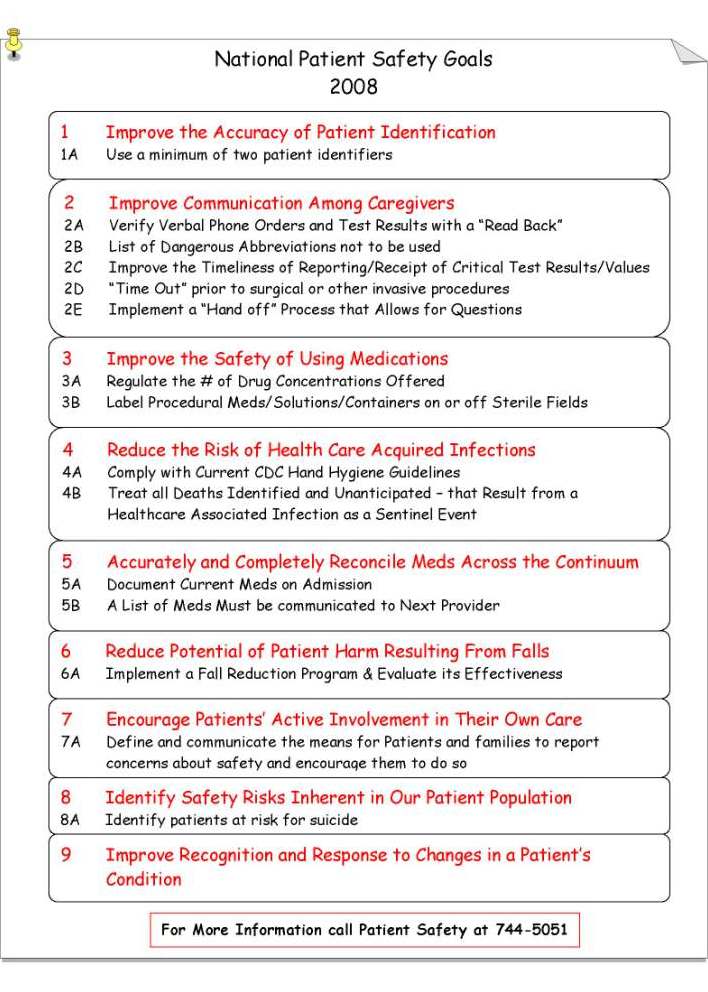
Patient Safety is important to everyone at HMC, and it is one of our key goals.
A way to meet our patient safety goals is to help identify yourself by always wearing your ID badge and help identify patients by always looking for their patient arm "ID band."
The two identifiers used to identify patients at HMC are the patient's name and their date of birth. "What is your name?" and "What is your date of birth?" should be asked. These identifiers are compared to the patient's ID band before any test or procedure.
Remember: HMC's Service Excellence standards ask us to introduce ourselves and ask what name a person would like to be called.
What type of patients will you see wearing the arm ID band?
- Patients who are in transport (outpatient), having testing, or are admitted to HMC.
Why does it matter that you ID the patient?
- To make sure the Right Person is getting the Right Care. For example, a transporter goes up to get a patient for a x-ray, they compare the patient's ID band to the transport requisition. When the patient gets to radiology, the radiology tech compares the patient's ID band to the test requisition. This ensures that the Right Patient is getting the Right Care.
In what departments are you more likely to see the arm ID band? You will see them on patients admitted to Harborview Medical Center or evaluated in the:
- Emergency Department
- Crisis Triage Unit
- Emergency Observation Unit
- Limited Stay Unit
- Or any patient undergoing an invasive procedure with or without sedation.
By following this simple plan, both staff and patients know that the Right Person is getting the Right Care!
By introducing yourself first and then asking the patient, "What is your name?" and "What is your date of birth?" help put people at ease.
Remember, some patients may be afraid or distressed and your introduction helps patients be more involved in their care and feel more comfortable about being in a hospital!
VERIFYING YOUR PATIENT'S ID MAY BE THE SAFEST THING YOU DO TODAY!
Did you know that ALL HMC employees, not only clinicians, need to know how to refer and report concerns about abuse and neglect victims?
Do you know what steps to take if you think that a patient is being abused or neglected?
For example, you see a visitor hit a bed-ridden 70-year-old patient or during the course of your work, you are told by a patient that her son has just stolen her life-time savings of $5,000. What would you do?
- All staff must report the incident immediately. It is the law for any employee who works in a health care facility.
- Find the nurse manager or charge nurse of the patient's unit or clinic and tell them about what you saw or heard. Use the patient's words whenever you can.
- Complete an online incident report. Patient Safety Net (PSN) is now the online method for completing all incident reports. Any suspected harm to patients, staff or visitors should be reported in PSN. This is also how to report unsafe conditions or near misses.
- Make sure you also tell your supervisor what has happened.
What happens after you report an incident?
- The patient's social worker will conduct an assessment and call the appropriate agency to make the report.
- Law enforcement agencies must also be contacted when physical or sexual assault is suspected.
Often at HMC you are working with patients, family members, and colleagues that are from different cultural backgrounds. There are a number of resources at HMC for you to access in order to help you increase your knowledge and understanding of other cultures. Here are two important resources:

Ethnomed.org: "The EthnoMed site contains information about cultural beliefs, medical issues and other related issues pertinent to the health care of recent immigrants to Seattle or the US . . . "
Interpreter Services and Community House Calls: The Interpreter Services and Community House Calls Program provides interpretation services and community support to our culturally diverse patient population. At Harborview, healthcare providers treat patients from over 70 different language groups with the help of a prearranged interpreter. Cultural interpretation or cultural mediation is offered as needed for our patients. Interpreters from the Community House Calls program serve refugee and immigrant patients speaking Amharic, Cambodian, Spanish, Somali, Tigrinia and Vietnamese by providing interpretation, case management and cultural mediation.
 HMC's
HMC's
HMC is a JCAHO recognized stroke center. All staff should know the five signs and symptoms of stroke:
- Sudden numbness or weakness of face, arm, leg- especially on one side of the body.
- Sudden confusion, trouble speaking or understanding.
- Sudden trouble seeing in one or both eyes.
- Sudden trouble walking, dizziness, loss of balance or coordination.
- Sudden severe headache with no known cause.
Individuals displaying these symptoms should be evaluated. Staff members should facilitate immediate transport of the individual to the ED (for visitors) or dial 222 for medical assistance.
Congratulations, you have completed the reading section of Module 5.
Next, click on "Take the Quiz" at the bottom of this screen.
If you have other modules and/or quizzes to complete, please return to the Competency Fair homepage to access them.
Last modified: 10/19/2009 4:18 PM